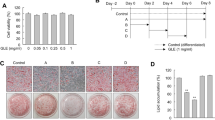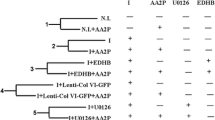Abstract
The present study was aimed to investigate the effect of zinc oxide (ZnO) nanoparticles on 3T3-L1 cell differentiation, by quantitating peroxisome proliferators-activated receptor γ (PPARγ), CCAAT/enhancer binding protein α (C/EBPα), fatty acid binding protein 4 (FABP4), sterol regulatory element-binding transcription factor 1 (SREBP1), and serine-threonine kinase cyclin-dependent kinase 4 (cdk4), which are critical for adipogenesis. 3T3-L1 preadipocyte cells were cultured and differentiated with the standard differentiation medium. Sulforhodamine B (SRB) assay determined 3T3-L1 cell viability. ZnO nanoparticles increased the lipid accumulation in differentiated adipocytes as evidenced by Oil Red O staining. The quantitative PCR (qPCR) analysis showed that the PPARγ, FABP4, C/EBPα, and SREBP1 messenger RNA (mRNA) expression was significantly increased in the ZnO nanoparticle-treated 3T3-L1 adipocytes. Western blot analysis showed increased PPARγ, FABP4, C/EBPα, and SREBP1 protein expression compared to their respective controls. Also, the immunofluorescence study showed the increased cdk4 and PPARγ expression in the nanoparticle-treated cells. Taking all these data together, it is concluded that ZnO nanoparticles may be a potent substance to alter 3T3-L1 preadipocyte differentiation and adipogenesis.








Similar content being viewed by others
References
Hirotaka U, Takakazu Y, Haruka A, Akihiro I, Satoshi I, Shouichi M, Akio I (2013) The roles of salivary secretion, brain-gut peptides, and oral hygiene in obesity. Obes Res Clin Pract 7:e321–e329
Muthuraman P, Senthilkumar R, Srikumar K (2009) Alterations in beta-islets of Langerhans in alloxan-induced diabetic rats by marine Spirulina platensis. J Enzym Inhib Med Ch 24(6):1253–1256
Arsène F, Tomoyasu T, Bukau B (2000) The heat shock response of Escherichia coli. Int J Food Microbiol 55:3–9
Hongo T (1994) Mineral and trace element nutrition. Daiichi Press, Tokyo, pp. 377–395
Muthuraman P, Enkhtaivan G, Bhupendra M, Chandrasekaran M, Rafi N, Kim DH (2015) Investigation of the role of aspartame in apoptosis process in Hela cells. Saudi J Biol Sci. doi:10.1016/j.sjbs.2015.06.01
Sen A, Lea-Currie YR, Sujkowska D, Franklin DM, Wilkison WO, Halvorsen YD, Gimble JM (2001) Adipogenic potential of human adipose-derived stromal cells from multiple donors is heterogeneous. J Cell Biochem 81:312–319
You Bing Y, Muthuraman P, Inho H (2013) The effect of Troglitazone, a PPARγ agonist on lipid accumulation and related gene expression in Hanwoo muscle satellite cell. J Physiol Biochem 69(1):97–109
Muthuraman P, Ramkumar K, Kim DH (2014) Analysis of the dose-dependent effect of zinc oxide nanoparticles on the oxidative stress and antioxidant enzyme activity in adipocytes. Appl Biochem Biotech 174(8):2851–2863
Pfaffl MW (2001) A new mathematical model for relative quantification in real-time RT-PCR. Nucleic Acids Res 29: e45.
Muthuraman P, Jeongeun P, Eunjung K (2014) Aspartame down-regulates 3T3-L1 differentiation. In Vitro Cell Dev Biol-Anim 50:851–857
Muthuraman P, Muthuviveganandavel V, Ravikumar K, Dongpil K (2014) Effect of cortisol on calpains in the C2C12 and 3T3-L1Cells. Appl Biochem Biotechnol 172:3153–3162
Muthuraman P, Srikumar K (2010) Induction of hexokinase I expression in normal and diabetic rats by a brassinosteroid isoform. Eur J Pharm Sci 41(1):1–9
White UA, Stephens JM (2010) Transcriptional factors that promote the formation of white adipose tissue. Mol Cell Endocrinol 318:10–14
Wang YX (2010) PPARs: diverse regulators of energy metabolism and metabolic diseases. Cell Res 20:124–137
Rabinovitch M (2010) PPARγ and the pathobiology of pulmonary arterial hypertension. Adv Exp Med Biol 661:447–458
Christodoulides C, Vidal-Puig A (2010) PPARs and adipocyte function. Mol Cell Endocrinol 318:61–68
Takahashi N, Goto T, Taimatsu A, Egawa K, Katoh S, Kusudo T, Sakamoto T, Ohyane C, Lee JY, Kim YI, Uemura T, Hirai S, Kawada T (2009) Bixin regulates mRNA expression involved in adipogenesis and enhances insulin sensitivity in 3T3-L1 adipocytes through PPARγ activation. Biochem Biophys Res Commun 390:1372–1376
Lefterova MI, Lazar MA (2009) New developments in adipogenesis. Trends Endocrinol Metab 20: 107-114.
Matsushime H, Roussel MF, Ashmun RA, Sherr CJ (1991) Colony-stimulating factor 1 regulates novel cyclins during the G1 phase of the cell cycle. Cell 65:701–713
Abella A, Dubus P, Malumbres M, Rane SG, Kiyokawa H, Sicard A, Vignon F, Langin D, Barbacid M, Fajas L (2005) Cdk4 promotes adipogenesis through PPARgamma activation. Cell Metab 2:239–249
Muthuraman P, Muthuviveganandavel V, Kim DH (2015) Cytotoxicity of zinc oxide nanoparticles on antioxidant enzyme activities and mRNA expression in the cocultured C2C12 and 3T3-L1 cells. Appl Biochem Biotech 175(3):1270–1280
May JM, Contoreggi CS (1982) The mechanism of the insulin-like effects of ionic zinc. J Biol Chem 257:4362–4368
Shisheva A, Gefel D, Shechter Y (1991) Insulin-like effects of zinc ion in vitro and in vivo. Preferential effects on desensitized adipocytes and induction of normoglycemia streptozocin-induced rats. Diabetes 41:982–988
Ezaki O (1981) IIb group metal ions (Zn2+, Cd2+, Hg2+) stimulate glucose transport activity by post-insulin receptor kinase mechanism in rat adipocytes. J Biol Chem 264:166118–116122
Fryer A, Miller ER, Ku PK, Ullrey DE (1992) Effect of elevated dietary zinc on growth performance of weanling swine. Michigan State Univ Rep of Swine Res 520:128
Hahn JD, Baker DH (1993) Growth and plasma zinc responses of young pigs fed pharmacological levels of zinc. J Anim Sci 71:3020–3024
Muthuraman P, Kim DH (2015) In vitro toxicity of zinc oxide nanoparticles: a review. J Nano Res 17:158
Brook CG, Lloyd JK, Wolf OH (1972) Relation between the age of onset of obesity and size and a number of adipose cells. BMJ 2:25–27
Acknowledgments
This paper was supported by the KU Research Professor Program of Konkuk University, Seoul, Republic of Korea.
Author information
Authors and Affiliations
Corresponding authors
Rights and permissions
About this article
Cite this article
Pandurangan, M., Jin, B.Y. & Kim, D.H. ZnO Nanoparticles Upregulates Adipocyte Differentiation in 3T3-L1 Cells. Biol Trace Elem Res 170, 201–207 (2016). https://doi.org/10.1007/s12011-015-0464-7
Received:
Accepted:
Published:
Issue Date:
DOI: https://doi.org/10.1007/s12011-015-0464-7




